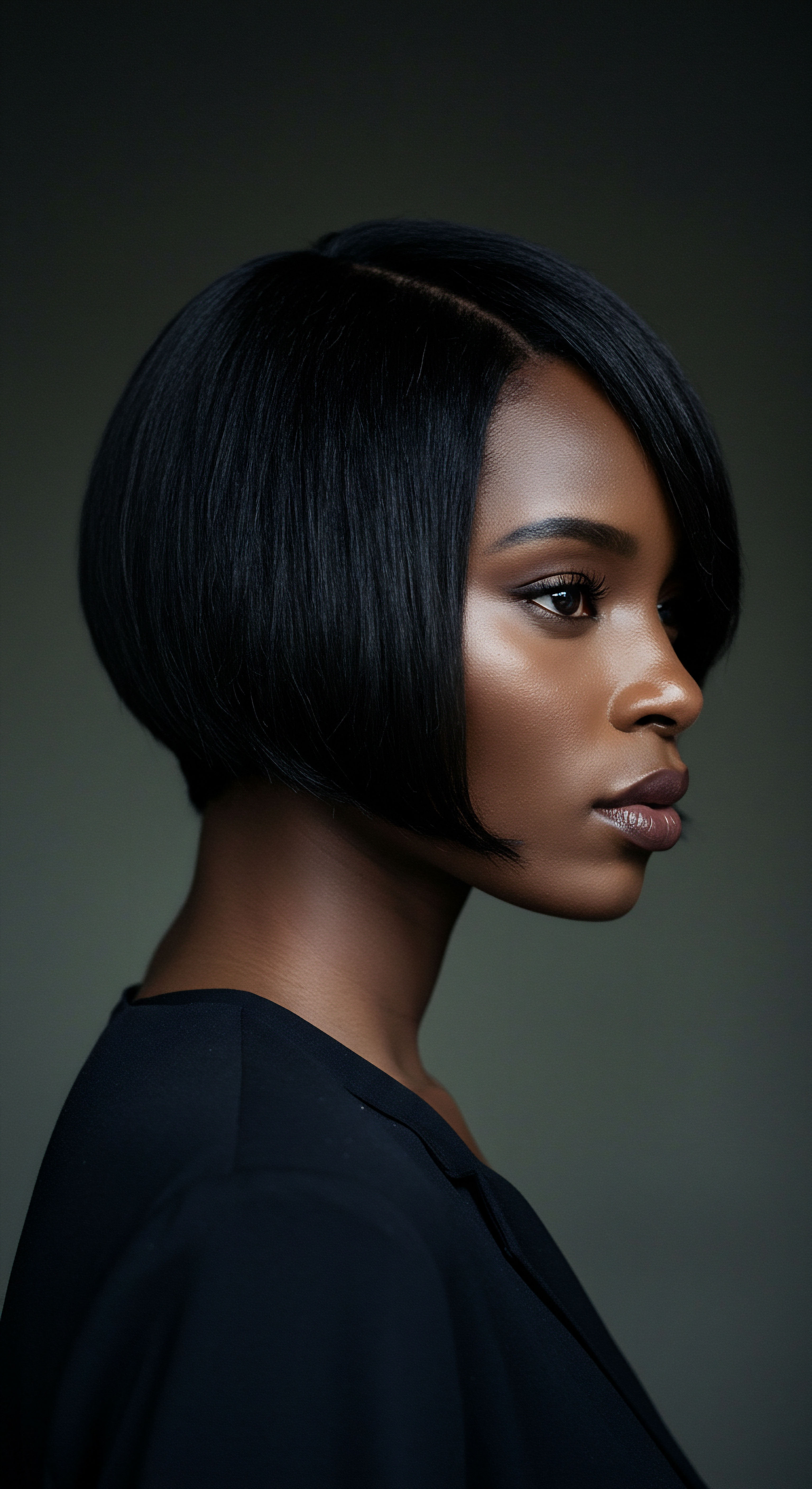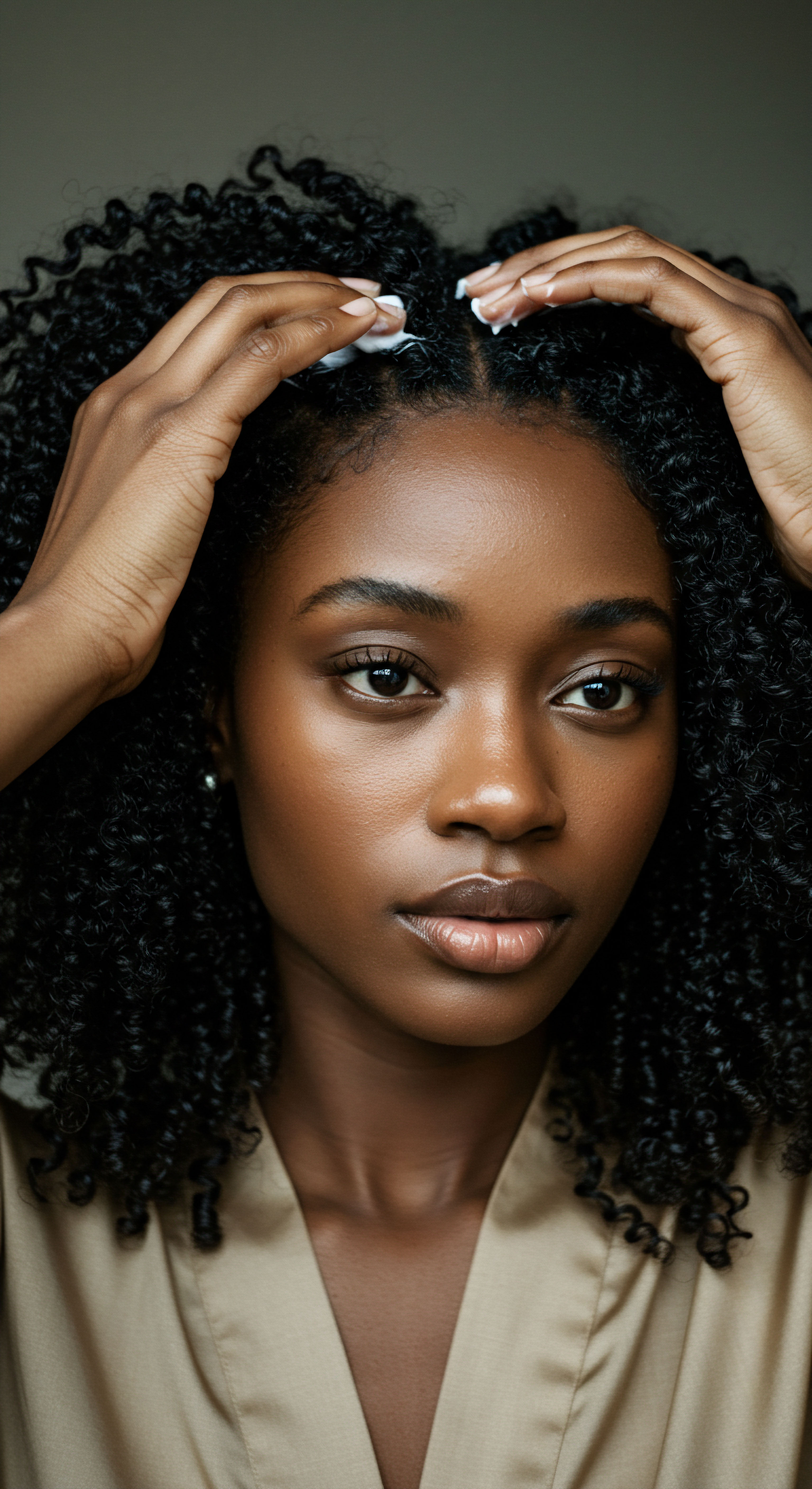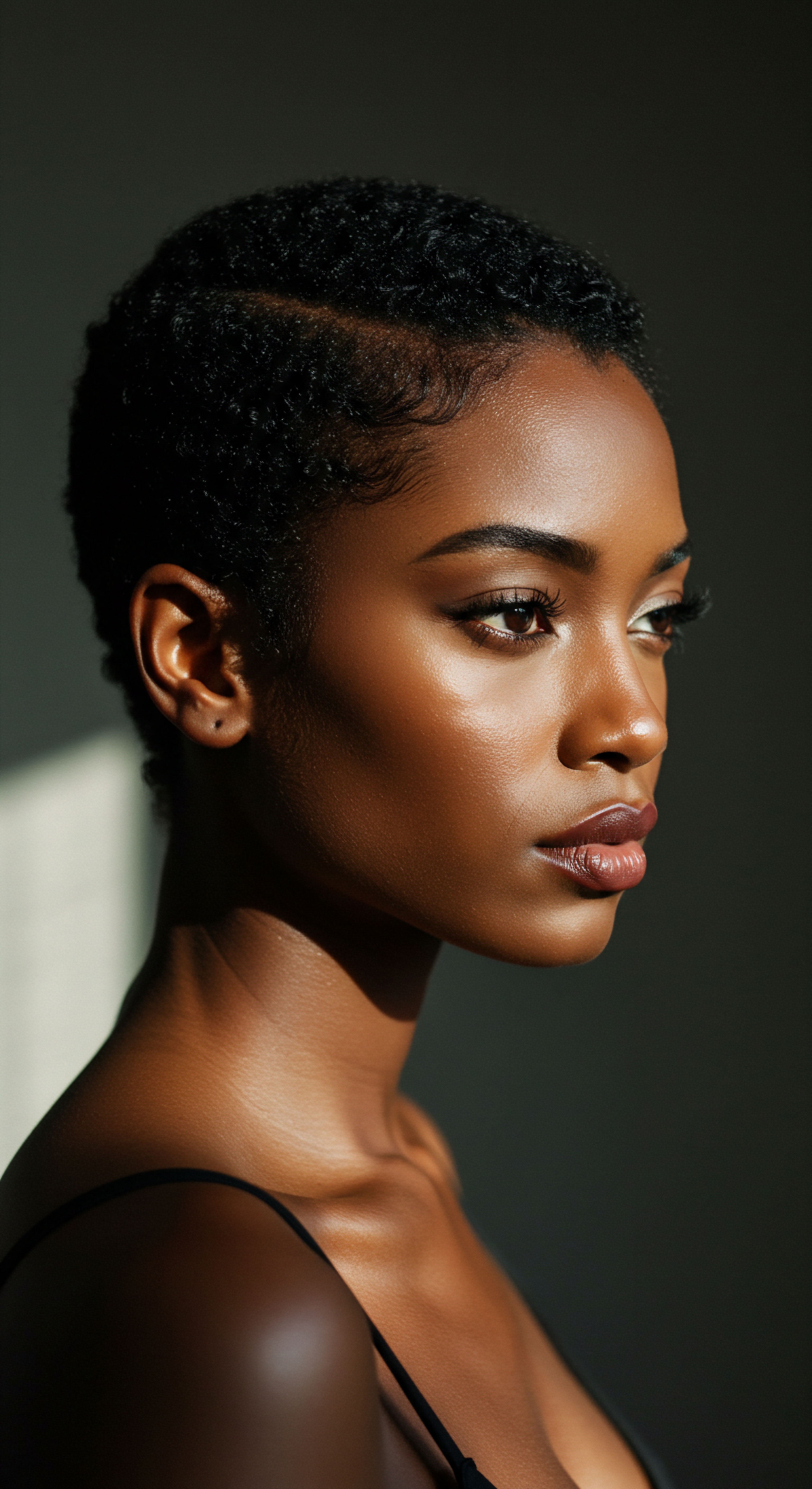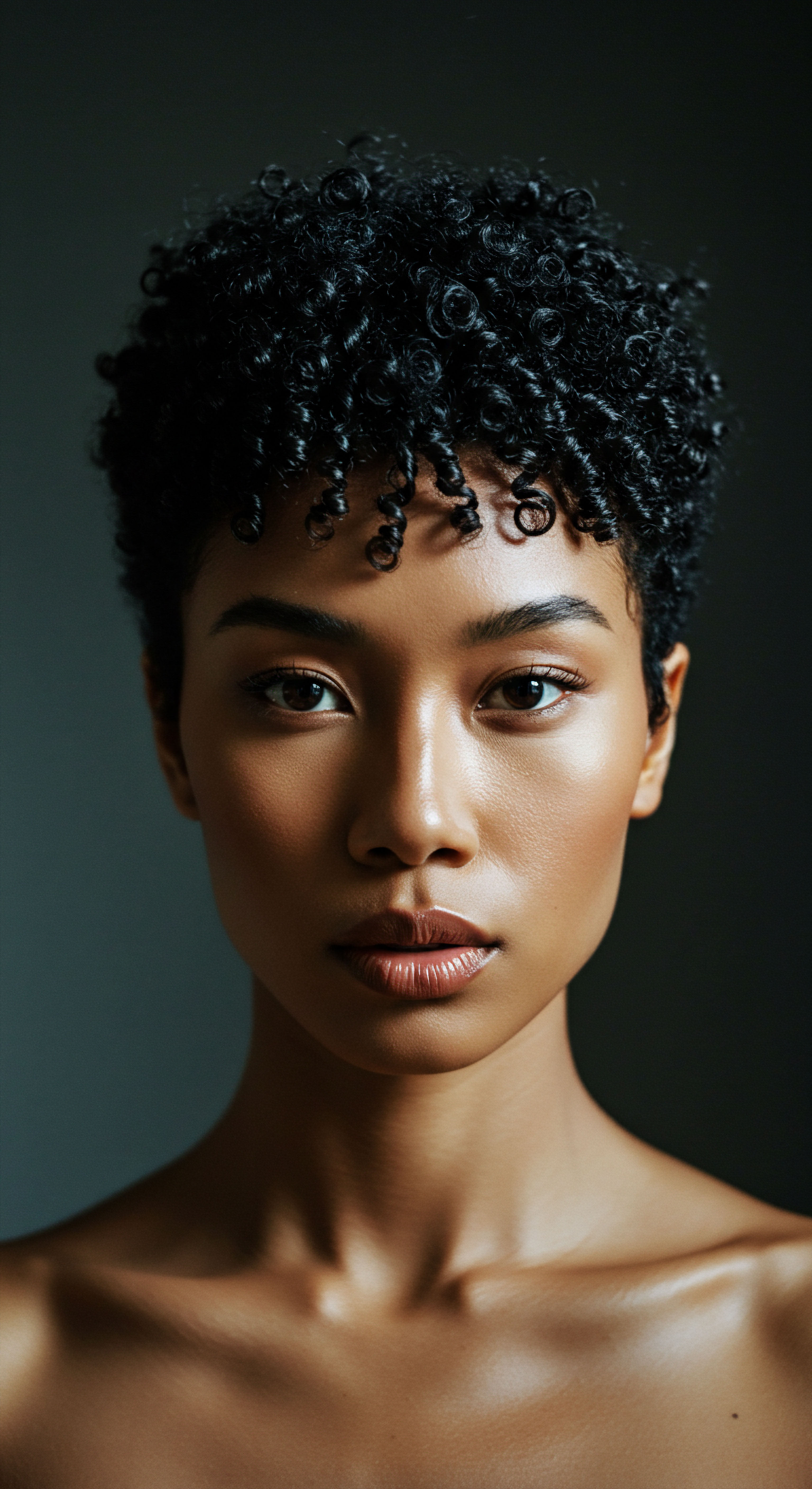The Himba hair tradition, centered around the application of otjize paste, stands as a profound example of a significant hair tradition from an African country. This practice, deeply rooted in the cultural fabric of the semi-nomadic Himba people of Namibia, transcends mere aesthetic adornment. It embodies a complex interplay of identity, social status, environmental adaptation, and personal care, offering a window into the rich historical and scientific wisdom held within indigenous practices. The distinctive reddish hue of their hair and skin, achieved through otjize, immediately sets them apart, symbolizing a deep connection to their ancestral land and the essence of life itself.

Roots
To truly appreciate the deep significance of hair traditions, one must first look to the foundational elements that shape them. Hair, for many cultures, is far more than a biological outgrowth; it acts as a living chronicle, reflecting identity, lineage, and connection to the very earth. In the sun-drenched landscapes of northern Namibia, amidst the arid Kunene region, resides the Himba people, whose hair practices stand as a powerful testament to this profound connection.
Their renowned tradition involves the daily application of otjize, a rich, reddish paste that cloaks both skin and hair, transforming their appearance into a striking, earthy canvas. This practice, often perceived by outsiders as purely cosmetic, actually speaks to centuries of accumulated knowledge about protection, well-being, and communal living.
The Himba, a semi-nomadic, pastoralist community, depend on their livestock for sustenance and wealth. Their lifestyle necessitates an intimate understanding of their environment, and their hair practices are no exception. The otjize paste itself is a blend of several components, each chosen for its specific properties. At its heart lies finely ground red ochre, a natural pigment derived from hematite stone.
This is combined with butterfat, typically from cows or goats, and often perfumed with the aromatic resin of the omuzumba shrub ( Commiphora multijuga ). The careful preparation of this paste, a ritual often performed by women, underscores the deliberate and knowledgeable approach to their personal care.
Himba hair practices are a profound expression of cultural identity, reflecting deep knowledge of their environment and well-being.

What are the Foundational Components of Himba Hair Care?
The core of Himba hair care rests upon the unique composition of otjize. The selection of its ingredients is not arbitrary; rather, it represents a practical response to the challenging desert environment.
- Red Ochre ❉ This powdered pigment, rich in iron oxides, gives otjize its characteristic red-brown color. Beyond its visual appeal, it plays a critical role in physical protection.
- Butterfat ❉ Derived from the milk of their cattle and goats, butterfat provides a rich, emollient base. This animal fat acts as a moisturizer, helping to seal moisture into the hair and skin, counteracting the drying effects of the arid climate.
- Aromatic Resins ❉ Resins from local shrubs, such as omuzumba, are incorporated for their scent. These aromatic additions serve a dual purpose, offering a pleasant fragrance and potentially possessing insect-repelling properties, a valuable attribute in their environment.
This blend is meticulously mixed to achieve a consistency suitable for application, allowing it to adhere to the hair strands and skin, forming a protective layer. The daily application of otjize ensures a continuous barrier against the elements.

How does the Himba Hair Tradition Align with Hair Anatomy?
While modern hair science dissects the cuticle, cortex, and medulla, the Himba tradition, without formal scientific terms, demonstrates an intuitive understanding of hair’s needs. The application of otjize provides a physical coating to the hair shaft, akin to a sealant. This external layer helps to:
- Protect the Cuticle ❉ The outermost layer of the hair, the cuticle, is the first line of defense against environmental damage. The otjize acts as a shield, preventing the cuticle from lifting and becoming brittle under the harsh sun and dry winds.
- Maintain Moisture Balance ❉ The butterfat component, a natural lipid, aids in retaining the hair’s natural moisture, preventing dehydration and breakage, particularly for textured hair types that can be prone to dryness.
- Enhance Resilience ❉ By coating the hair, the paste adds weight and density, which can reduce tangling and mechanical stress, thereby contributing to the overall resilience of the strands. This physical protection allows the hair to grow long and strong, a symbol of health and vitality within their community.
This ancient practice, therefore, aligns with fundamental principles of hair health, ensuring the structural integrity of the hair in a challenging environment. The Himba’s approach highlights a profound, inherited understanding of their hair’s needs, passed down through generations.

Ritual
Stepping beyond the foundational understanding of otjize, we enter the realm of daily practice, where the Himba hair tradition truly comes alive. The application of otjize and the styling of hair are not isolated acts; they represent a continuous, lived experience, deeply integrated into the rhythm of Himba life. This section considers the practical wisdom embedded in these routines, offering insight into how these practices are maintained and what they signify in the everyday. It is a world where hair care is a communal endeavor, a moment of connection, and a silent language.
The process of applying otjize is a meticulous daily ritual, particularly for Himba women. They begin their mornings by preparing the paste, ensuring its consistency and scent are just right. This involves warming the butterfat and carefully mixing in the ochre and resin.
Once ready, the rich, red paste is applied generously to their bodies and hair, creating a distinctive, almost glowing, reddish-brown hue. This application is often a communal activity, with women assisting one another, reinforcing social bonds and transmitting the precise techniques through observation and participation.
Himba hair care is a daily, communal ritual, signifying social standing and a profound connection to their environment.

How are Himba Hairstyles Created and Maintained?
Himba hairstyles are a visual lexicon, communicating age, marital status, and social standing within the community. The creation and maintenance of these styles involve specific techniques and often incorporate additional elements.
- Childhood Styles ❉ Young Himba children typically have their heads shaved or a small patch of hair on the crown. As they grow, boys usually wear a single plait at the back of the head, while young girls wear two plaits, called ozondato, extending forward over their eyes. The specific form of these plaits can even be determined by their oruzo (patrilineal descent group).
- Puberty and Beyond ❉ Upon reaching puberty, a girl’s hairstyle transforms. The two front plaits are often swept back, lengthened, and heavily coated with otjize. For teenage girls nearing marriageable age, strands might hang over their face, a symbolic gesture indicating they are not yet ready for marriage. When a girl completes her puberty ceremony, she may receive an ekori headdress, made from tanned goatskin, further signifying her new status.
- Married Women’s Styles ❉ Married women wear the most elaborate styles, often featuring numerous thick, otjize -coated braids. After about a year of marriage or upon having a child, a woman adopts the erembe headdress, sculpted from sheep or goatskin, adorned with many streams of braided hair. These styles are not simply static adornments; they require continuous care, with women spending hours each day tending to their hair and complexion.
To achieve the desired length and volume for these elaborate styles, Himba women often incorporate extensions made from goat hair, hay, or even artificial hair. This practice highlights a practical approach to achieving culturally significant aesthetics.
Maintaining these complex styles also involves sleeping on wooden pillows to preserve the intricate work, preventing the hair from being flattened or disarranged during the night.

What Tools are Used in Himba Hair Care?
The tools employed in Himba hair care are as traditional and resourceful as the otjize itself, often derived from natural materials available in their environment.
- Mixing Bowls and Stirrers ❉ For preparing the otjize paste, simple bowls, often made from gourds or wood, are used to mix the red ochre, butterfat, and resin. Stirrers or pestles, typically stone or wood, aid in achieving the desired smooth consistency.
- Application Utensils ❉ While much of the application is done by hand, specific tools might be used for precise application or to work the paste into the hair evenly. Fingers are primary tools for sculpting and coating.
- Styling Aids ❉ Beyond the hands, natural elements like sticks or sharpened pieces of wood may be used to section hair or aid in the braiding process. The ekori and erembe headdresses themselves are crafted from animal skins, representing specialized cultural tools for adornment and status signaling.
- Wooden Pillows ❉ These specialized headrests are crucial for preserving the intricate hairstyles during sleep. They lift the head, preventing the otjize -coated braids from being crushed or altered, thus reducing the need for extensive restyling each morning.
The absence of modern combs or brushes, as understood in Western hair care, underscores the effectiveness of their traditional methods, where the rich paste and skilled hands suffice for detangling and smoothing.
| Life Stage or Status Infant / Young Child |
| Typical Hairstyle Shaved head or small tuft on crown |
| Associated Adornments Minimal or no adornments |
| Life Stage or Status Young Boy |
| Typical Hairstyle Single plait at back of head |
| Associated Adornments None specified in sources |
| Life Stage or Status Young Girl |
| Typical Hairstyle Two plaits ( ozondato ) forward over eyes |
| Associated Adornments Simple, if any, ornaments |
| Life Stage or Status Pubescent Girl |
| Typical Hairstyle Longer plaitlets, sometimes veiling face |
| Associated Adornments May include ekori headdress at initiation |
| Life Stage or Status Married Woman |
| Typical Hairstyle Numerous thick, otjize -coated braids |
| Associated Adornments Erembe headdress, copper/iron necklaces, ohumba shell necklace |
| Life Stage or Status Single Man |
| Typical Hairstyle Single plait ( ondatu ) at back of head, rest shaved |
| Associated Adornments None specified in sources |
| Life Stage or Status Married Man |
| Typical Hairstyle Hair covered by turban |
| Associated Adornments Turban, sometimes scratch implement |
| Life Stage or Status These styles communicate age, marital status, and social standing within the Himba community. |

Relay
Moving beyond the practical application of otjize and the daily rituals, the Himba hair tradition reveals itself as a profound cultural phenomenon, a living testament to resilience, adaptation, and deep communal ties. This final section delves into the intricate layers of meaning, the scientific underpinnings, and the broader societal implications of this practice. It is a journey into the heart of Himba identity, where hair becomes a canvas for history, a shield against the elements, and a statement of enduring heritage.
The significance of Himba hair extends far beyond personal adornment; it is a visual narrative, a silent language understood by every member of the community. Each style, each application of otjize, carries information about an individual’s life stage, their marital status, their lineage, and even their wealth. This complex system of non-verbal communication reinforces social structures and identity, allowing for immediate recognition and understanding within the group. The act of communal hair braiding, often involving close relatives, strengthens familial bonds and serves as a conduit for passing down traditional knowledge and stories from one generation to the next.
The Himba hair tradition, through otjize and styling, acts as a dynamic cultural language, communicating identity, status, and communal ties.

What is the Cultural Meaning behind Himba Hair Traditions?
The Himba hair tradition is steeped in symbolism, reflecting their worldview and values. The most prominent symbol is the color red, imparted by the ochre in otjize. This vibrant hue represents:
- Blood and Life ❉ The red color symbolizes blood, the essence of life, and the vitality of the Himba people.
- Earth and Ancestral Land ❉ It connects them to the rich, red earth of their ancestral home, the arid landscapes of Namibia. This connection signifies a deep respect for nature and their environment.
- Beauty and Fertility ❉ The reddish glow of otjize is considered the ideal standard of beauty for Himba women. Thick, lustrous hair, often enhanced by otjize, is also associated with fertility and a woman’s ability to bear healthy children.
Beyond color, specific hairstyles denote various life stages. The transformation of a girl’s hairstyle from forward-facing plaits to swept-back, otjize -coated braids, and the eventual adoption of the erembe headdress, are not merely changes in fashion. They are public declarations of rites of passage, marking transitions from childhood to puberty, and then to marriage and motherhood. These visible markers ensure that an individual’s social standing is clear to all, facilitating interactions and maintaining social order.

How does Otjize Provide Environmental Adaptation?
The Himba live in one of Earth’s most challenging environments, characterized by intense sun and scarce water. The otjize paste serves as a sophisticated, natural solution to these environmental pressures, demonstrating an ancient understanding of photoprotection and hygiene.
For centuries, the Himba have used otjize to protect their skin and hair from the harsh desert sun. Modern scientific inquiry has begun to validate this traditional wisdom. A 2015 study, published in the South African Journal of Science, specifically investigated the photoprotective effects of red ochre on human skin through in vitro laboratory experiments.
Researchers found that red ochre possesses the capacity to inhibit the detrimental effects of ultraviolet radiation (UVR). The study concluded that the habitual use of red ochre as a photoprotective agent likely played a role in the ability of prehistoric humans to adapt to novel environmental circumstances.
This research suggests that the iron oxides present in ochre act as a physical blocker against UV rays, similar to how modern mineral sunscreens operate. The butterfat component also creates a barrier, further augmenting this protection and preventing moisture loss from the skin and hair due to the dry air. This natural sunscreen not only shields against sunburn but also helps to prevent premature aging of the skin and hair damage from prolonged sun exposure.
Furthermore, in an environment where water is a precious commodity and traditional bathing with water is rare, otjize contributes to hygiene. As the paste gradually flakes off over time, it removes dirt, dead skin cells, and impurities, serving as a dry cleansing method. The aromatic resins also provide a pleasant scent, acting as a natural deodorant. This ingenious system highlights a sustainable and effective approach to personal care, tailored precisely to their ecological context.
The Himba’s ability to thrive in such an extreme climate, partly due to their hair and body care practices, offers a compelling case study in human adaptation and the scientific validity of indigenous knowledge.
| Component Red Ochre |
| Primary Function UV protection (physical blocker) |
| Additional Benefits Aesthetic color, cultural symbolism (blood, earth) |
| Component Butterfat |
| Primary Function Moisturizing and sealing |
| Additional Benefits Skin conditioning, hair flexibility, binding agent for ochre |
| Component Aromatic Resins |
| Primary Function Fragrance |
| Additional Benefits Insect repellent properties, ceremonial significance |
| Component Each ingredient in otjize serves a specific practical purpose, contributing to the overall well-being and cultural expression of the Himba people. |

Reflection
The Himba hair tradition, with its vibrant otjize and intricate styling, offers a profound reminder of hair’s capacity to carry meaning beyond mere appearance. It stands as a living testament to the deep connections between personal identity, communal values, and environmental wisdom. For Roothea, understanding such traditions is a gentle invitation to consider our own relationship with our hair – not just as a matter of products and techniques, but as a reflection of history, self-acceptance, and a celebration of natural beauty. It encourages us to look beyond the surface, recognizing the stories and knowledge held within every strand, and to appreciate the profound artistry that can unfold when care is rooted in cultural heritage and an intimate understanding of nature’s offerings.

References
- Byrd, A. D. & Tharps, L. L. (2002). Hair Story ❉ Untangling the Roots of Black Hair in America. St. Martin’s Press.
- Dabiri, E. (2020). Twisted ❉ The Tangled History of Black Hair Culture. Harper Perennial.
- IbhaZe, O. L. (2022). Crowning Glory ❉ A History of African Hair Tradition. AFRICA IS NOT A COUNTRY SERIES BY OLUNOSEN LOUISA IBHAZE.
- Rifkin, R. F. d’Errico, F. Dayet-Boulliot, L. & Summers, B. (2015). Assessing the photoprotective effects of red ochre on human skin by in vitro laboratory experiments. South African Journal of Science, 111(3-4), 1-8.
- Sieber, R. & Herreman, F. (2000). Hair in African Art and Culture. The Museum for African Art.
- Sherrow, V. (2006). Encyclopedia of Hair ❉ A Cultural History. Greenwood Publishing Group.